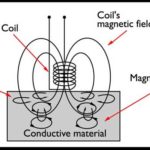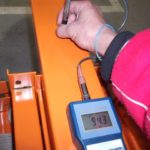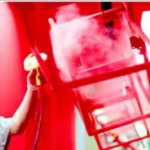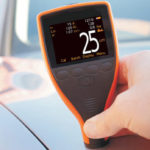Coating Thickness Measurement ISO 2360:2003
now browsing by tag
Test for edge effect -ISO2360 2003
A simple edge effect test, to assess the effect of the proximity of an edge, consists in using a clean uncoated sample of the basis metal as follows. The procedure is illustrated in Figure B.1. Step 1 Place the probe on the sample, well away from the edge. Step 2 Adjust the instrument to read zero. Step 3 Progressively bring the probe towards the edge and note where a change of the instrument reading occurs with respect to the expectedRead More …
Eddy current generation in a metallic conductor

A.1 General Eddy current instruments work on the principle that a high frequency electromagnetic field generated by the probe system of the instrument will produce eddy currents in an electrical conductor on which the probe is placed. These currents result in a change of the amplitude and/or the phase of the probe coil impedance, which can be used as a measure of the thickness of the coating on the conductor (see Example 1) or of the conductor itself (see ExampleRead More …
7 Expression of results – ISO2360

7 Expression of results The expression and presentation of results shall be agreed between interested parties and normally includes: -a list of all the readings taken; -the mean, maximum, minimum readings; -the standard deviation and/or coefficient of variation. 8 Measurement uncertainty The instrument, its calibration, and its operation shall be such that the coating thickness can be determined to within 10 % of its true thickness. 9 Test report The test report shall include the following information: a) all informationRead More …
Procedure of Measurement of coating thickness- ISO 2360

6 Procedure of Measurement of coating thickness 6.1 Calibration of instruments 6.1.1 General Before use, each instrument shall be calibrated in accordance with the manufacturer’s instructions, using suitable calibration standards. Particular attention shall be paid to the description given in Clause 3 and to the factors described in Clause 5. In order to minimize conductivity changes due to temperature variations, at the time of calibration the instrument and the calibration standards shall be at a temperature close to the temperatureRead More …
Factors affecting measurement uncertainty -ISO 2360

Measurement of coating thickness INTERNATIONAL STANDARD ISO 2360 5 Factors affecting measurement uncertainty 5.1 Coating thickness A measurement uncertainty is inherent in the method. For thin coatings, this measurement uncertainty (in absolute terms) is constant, independent of the coating thickness and, for a single measurement, is at least 0,5μm. For coatings thicker than 25 μm, the uncertainty becomes relative to the thickness and is approximately a constant fraction of that thickness. For measuring coating thicknesses of 5 μm or less,Read More …
Measurement of coating thickness – ISO 2360:2003 -Part 1

Non-conductive coatings on non-magnetic electrically conductive basis materials — Measurement of coating thickness — Amplitude-sensitive eddy current method INTERNATIONAL STANDARD ISO 2360 Third edition 1 Scope This International Standard describes a method for non-destructive measurements of the thickness of non-conductive coatings on non-magnetic, electrically conductive (generally metallic) basis materials, using amplitude-sensitive eddy current instruments. NOTE This method can also be used to measure non-magnetic metallic coatings on non-conductive basis materials. The method is particularly applicable to measurements of the thicknessRead More …

 D5 Creation
D5 Creation